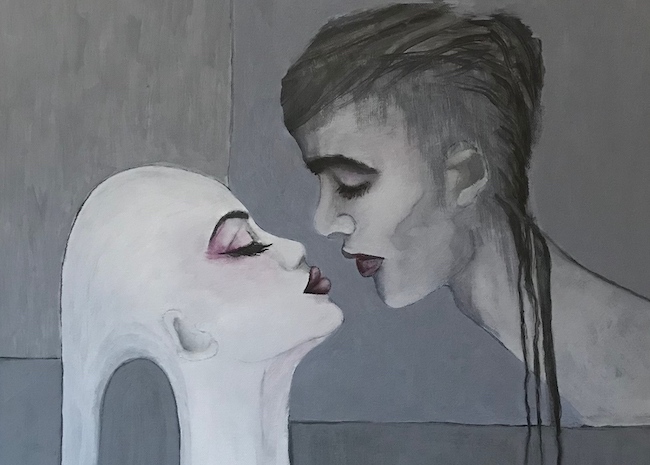Il dualismo del vivere contemporaneo induce molto spesso le persone a creare delle maschere, delle personalità differenti attraverso le quali confrontarsi con se stesse oppure con il mondo esterno, confondendo a volte l’immagine che si desidera far percepire all’esterno con quella di cui invece si dovrebbe sempre essere consapevoli, quella legata alla vera essenza. L’artista protagonista di oggi indaga con sguardo curioso sulle maschere, o per meglio dire sulle facciate che gli individui mostrano, cercando di svelare ciò che tendono a nascondere.
Il mondo artistico del Ventesimo secolo fu scosso da una radicale trasformazione nel modo di intendere l’arte poiché da un lato divenne prioritaria l’emozione a discapito del senso estetico e della perfetta riproduzione della realtà che avevano contraddistinto i secoli precedenti, dall’altro al contrario l’atto creativo doveva essere epurato da ogni sensazione personale dell’esecutore dell’opera e distaccarsi completamente da tutto ciò che poteva essere osservato e facilmente riprodotto dalle moderne tecnologie. Espressionismo e Astrattismo furono in antitesi, pur avendo entrambi come scopo finale quello di compiere un netto distacco, una rottura definitiva con l’arte come era stata fino alla fine del secolo precedente; laddove il primo si propose di andare a scavare all’interno della soggettività, delle pulsioni più reali e intime dell’artista, di contro il secondo puntò sull’oggettività, sulla supremazia del gesto plastico rispetto alla contingenza e sulla tesi che l’arte potesse esistere a prescindere dalle sensazioni. Nel corso dei primi anni del Novecento, quelli in cui i conflitti mondiali e le ricostruzioni post-belliche suscitarono nella popolazione e negli ambienti culturali un senso di incertezza, di destabilizzazione e di angoscia per tutto ciò a cui si era assistito, si era generata la necessità in molti artisti dell’epoca di far sentire la propria voce emotiva, gridare il proprio dolore, raccontare il senso di precarietà e di isolamento con cui molti dovevano fare i conti, trasformando dunque l’arte in mezzo di comunicazione di quelle inquietudini da cui il loro animo non poteva più prescindere. Inizialmente più legati alle teorie coloristiche dei Fauves, nel corso del tempo gli espressionisti personalizzarono il linguaggio pittorico sulla base del proprio sentire, a volte dissolvendo i contorni dei soggetti raffigurati, per lasciar fuoriuscire i sentimenti che continuavano sentir rumoreggiare dentro di sé, altre invece dissolvendo i colori fin quasi a farli divenire cupi, oppure terrosi, o semplicemente sfumati così come lo era il vortice di sensazioni che dovevano narrare. Dunque dalle tonalità inquiete ma solari dell’ingenua follia di Vincent Van Gogh si passa alle atmosfere scure e tempestose di Edvard Munch per finire alle immagini deformate e a tinte cipriate di Egon Schiele, splendidi esempi della poliedricità espressiva della corrente. Gabriele Springer, artista tedesca con un percorso di vita che l’ha condotta a vivere per lavoro in molte città della Germania e dell’Olanda, elabora un suo personale Espressionismo attraverso il quale esplora tutto ciò che gli individui tendono a nascondere, a celare oltre la facciata che scelgono di presentare al mondo durante quel vivere quotidiano che li induce a mettersi a confronto, e spesso in scontro, con una parte di se stessi che non è quella reale perché mostrarla li farebbe sentire troppo esposti, troppo facilmente colpibili.
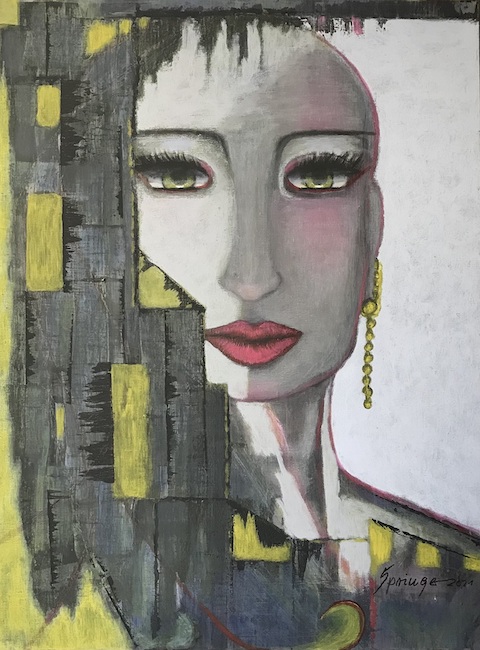
Ciò che affascina l’artista sono i volti nelle loro espressioni distratte, quando inconsapevoli di essere osservati lasciano trasparire quella sensazione nascosta, quella perplessità, quell’intensità, che un istante dopo si affrettano a mascherare dietro la facciata pubblica, cosciente, sotto il pieno controllo della ragione.
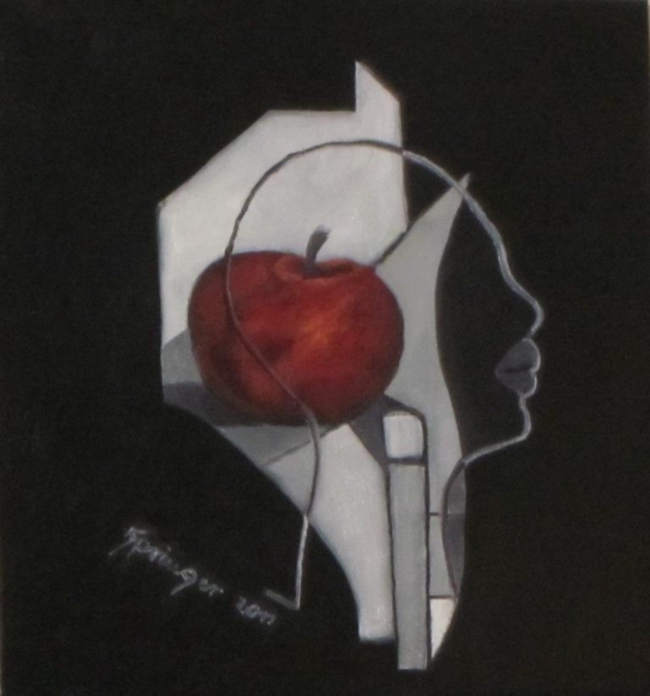
Le tonalità delle opere di Gabriele Springer sono scure, funzionali a richiamare la scena teatrale, quella in cui Pirandello fu pioniere nell’esplorare la medesima tematica, quella delle maschere, e che è fondamentale per l’artista per infondere nell’osservatore quell’attenta curiosità, quel sentirsi in qualche modo coinvolto proprio in virtù della consapevolezza di essere egli stesso il protagonista degli atteggiamenti ritratti, di quei veli di mistero nei quali spesso si sente ingabbiato seppur incapace di rinunciarvi, perché sentirsi scoperti è rischioso, perché lasciarsi leggere significherebbe rivelare ciò che spesso non si riesce ad ammettere.
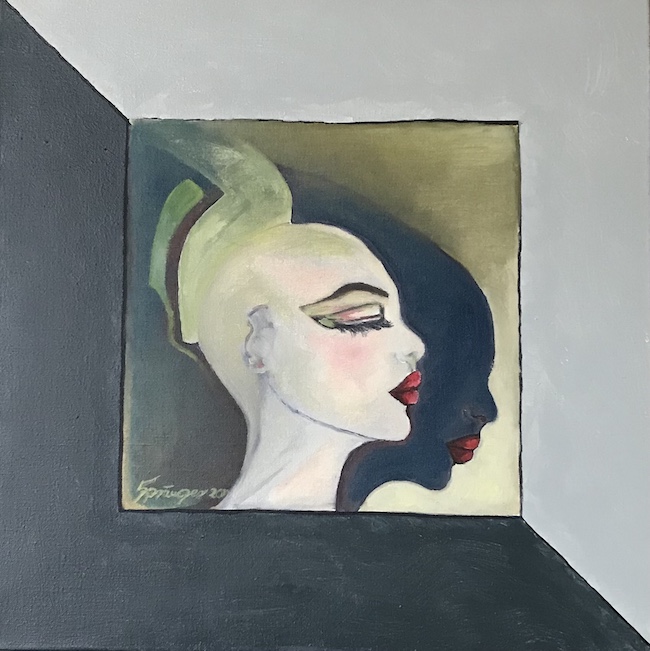
Sono quelli i frangenti che la Springer esplora, e che mette in evidenza come davanti all’occhio di bue che illumina il palcoscenico, come nella tela Die Schattenfrau (La donna ombra) in cui la protagonista appare algida, orgogliosa e piena di sé mentre la sua ombra, il lato privato, quello che mostra solo a se stessa nella solitudine dei suoi pensieri, è ripiegato su se stesso, il capo reclinato ad accogliere e percepire le ferite che, inevitabilmente, porta dentro. Non vi è giudizio nelle opere di Gabriele Springer, solo l’inclinazione naturale a voler indagare e capire la psiche umana, quel respiro interiore che non può fare a meno di fuoriuscire, a volte in maniera più evidente, altre in maniera più timida, dalle espressioni inconsapevoli.
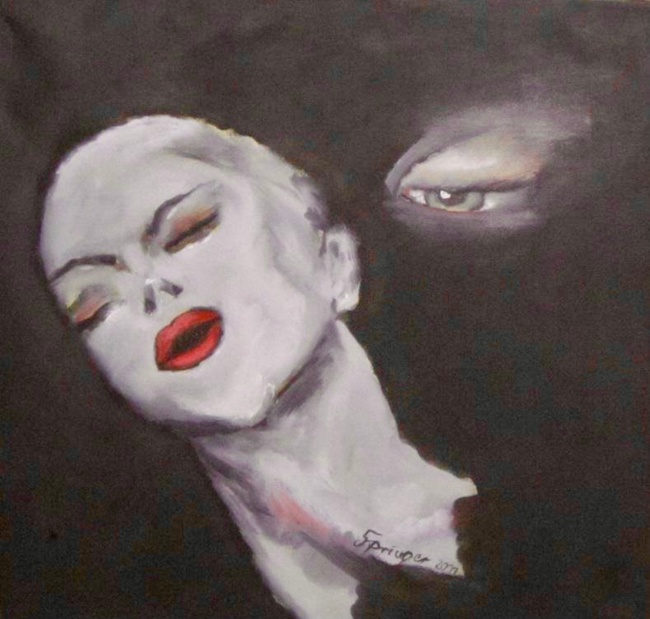
In Ich beobachte dich (Io ti osservo) la donna al centro della tela sembra lasciarsi andare a un dolore fino a quel momento trattenuto, probabilmente sicura di non essere vista; in realtà invece c’è dietro di lei uno sguardo che la osserva, qualcuno che cerca di spiare la sua reazione, difficile dire se per comprenderla o semplicemente per capire la conseguenza di un’azione compiuta dallo stesso osservante. Emerge in quest’opera l’ambivalenza dell’altro che può essere ostile oppure empatico, ed è proprio nell’incertezza che assale l’individuo nel vivere contemporaneo che nasce l’esigenza di nascondersi dietro un’armatura, un’apparenza di imperturbabilità che in qualche modo diviene una protezione utile per avere il tempo di comprendere meglio chi si trova di fronte.
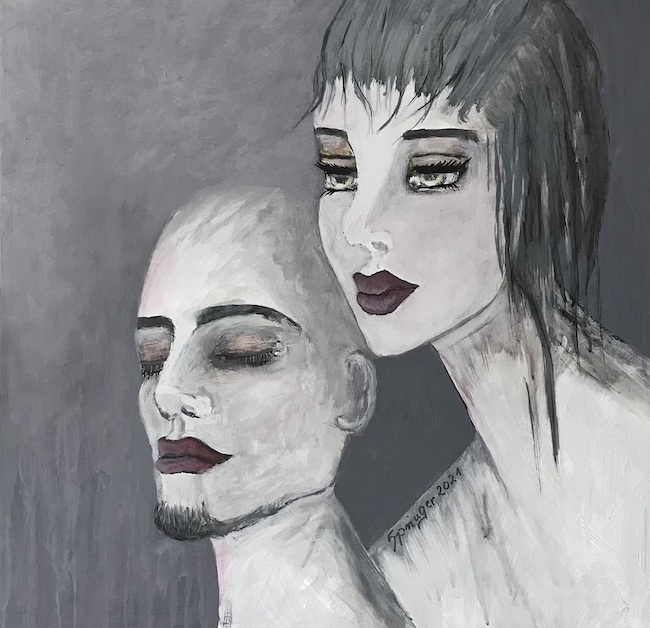
Nella tela Du hast gesagt dass es Liebe war (Hai detto che era amore) Gabriele Springer scruta l’espressione disillusa della donna, quel sentir sfuggire un sentimento inizialmente forte e coinvolgente che però poi si perde nelle pieghe della quotidianità, in quel non provare più la medesima scossa e il medesimo entusiasmo che aveva contraddistinto i primi tempi perché poi tutto si stabilizza su un binario più tranquillo, più ordinario, fin quasi a trasformarsi in indifferenza. Il volto dell’uomo infatti sembra distaccato, distratto e assolto da pensieri che lo allontanano dall’amata, si percepisce in qualche modo il senso di noia asfissiante che contraddistingue le relazioni in cui entrambe le parti si conoscono e, malgrado le sensazioni precedentemente provate, non sentono più di poter proseguire il percorso insieme. La donna, al contrario, sembra aggrapparsi a una possibilità, forse l’unica, di far rinascere quell’amore che sente scivolare via dalla sua vita. Anche in questo dipinto le tonalità sono scure, è eseguito quasi in scala di grigi se non fosse per le labbra piegate agli angoli in un’espressione di amarezza, di delusione, che evidenziano la mancanza di colore e di vivacità di un rapporto che sta avviandosi alla sua conclusione.
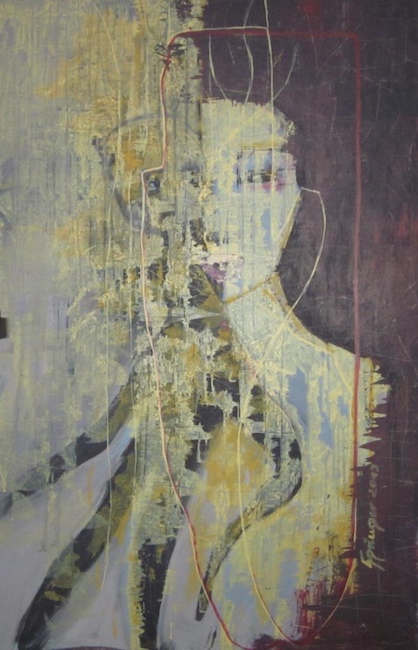
Stessa sensazione malinconica emerge nell’opera Vom anderen Stern (Da un’altra stella) seppur quasi completamente celata non solo dal velo che occupa metà della tela ma anche dai graffi e dalla trasparenza che la Springer usa per raccontare il pensiero nostalgico, il desiderio di trovarsi in un altro posto e in un altro luogo in cui tutto può ricominciare o semplicemente essere diverso.

Pittrice, decoratrice, artigiana del vetro, creatrice di gioielli, progettista di giardini, insegnante d’arte, Gabriele Springer ha partecipato a numerosissime mostre in Germania e anche all’estero.
GABRIELE SPRINGER-CONTATTI
Email: kuenstlerin@gabriele-springer.de
Sito web: https://www.kuenstlerin-gabriele-springer.de
Facebook: https://www.facebook.com/gabriele.springer.9
Instagram: https://www.instagram.com/kuenstlerin.gabriele.springer/
Discovering the innermost self in the Expressionist artworks of Gabriele Springer
The dualism of contemporary life very often leads people to create masks, different personalities through which they can confront themselves or the outside world, sometimes confusing the image they wish to be perceived externally with the one they should always be aware of, the one linked to their true essence. Today’s protagonist artist investigates with a curious gaze the masks, or rather the facades that individuals display, trying to reveal what they tend to hide.
The artistic world of the twentieth century was shaken by a radical transformation in the way art was understood, since on the one hand emotion became a priority, to the detriment of the aesthetic sense and perfect reproduction of reality that had characterised previous centuries. On the other hand, the creative act had to be purged of all personal feelings of the artwork’s creator and completely detached from everything that could be observed and easily reproduced by modern technology. Expressionism and Abstractionism were antithetical, even though both had the ultimate aim of making a clear break with art as it had been until the end of the previous century; whereas the former aimed to delve into the subjectivity, the artist’s most real and intimate drives, the latter focused on objectivity, on the supremacy of the plastic gesture over contingency and on the thesis that art could exist regardless of feelings. During the early years of the 20th century, when the world wars and post-war reconstructions aroused a sense of uncertainty, destabilisation and anxiety in the population and cultural circles, many artists of the time felt the need to make their emotional voices heard, to cry out their pain, to recount the sense of precariousness and isolation with which many had to deal, thus transforming art into a means of communicating those anxieties that their souls could no longer ignore.
Initially more closely linked to the colouristic theories of the Fauves, over time the Expressionists personalised the pictorial language on the basis of their own feelings, sometimes dissolving the outlines of the subjects depicted, to let the feelings they continued to hear rumble within themselves escape, and at other times dissolving the colours almost to the point of making them gloomy, or earthy, or simply blurred as was the whirlwind of sensations they were meant to narrate. So, from the restless but sunny tones of Vincent Van Gogh’s naive madness, we move on to Edvard Munch’s dark and stormy atmospheres and finally to Egon Schiele’s deformed and powdery images, splendid examples of the expressive versatility of the current. Gabriele Springer, a German artist whose life has taken her to live and work in many cities in Germany and Holland, has developed her own personal Expressionism through which she explores all that individuals tend to hide, to conceal beyond the facade they choose to present to the world during their daily lives, which leads them to confront, and often clash, with a part of themselves that is not the real thing because showing it would make them feel too exposed, too easily hit. What fascinates the artist are the faces in their distracted expressions, when unaware of being observed they allow that hidden sensation to shine through, that perplexity, that intensity, which a moment later they hasten to mask behind the public, conscious facade, under the full control of reason. The tonalities of Gabriele Springer’s paintings are dark, functional to recall the theatrical scene, the one in which Pirandello was a pioneer in exploring the same theme, that of masks, and which is fundamental for the artist to instil in the observer that attentive curiosity, that feeling of being involved in some way, precisely because he is aware that he himself is the protagonist of the attitudes portrayed, of those veils of mystery in which he often feels trapped, even though he is incapable of renouncing them, because feeling exposed is risky, because letting oneself be read would mean revealing what one is often unable to admit.
These are the junctures that Springer explores, and which she highlights as if in front of the bull’s eye light that illuminates the stage, as in the painting Die Schattenfrau (The Shadow Woman) in which the protagonist appears algid, proud and full of herself while her shadow, her private side, the one she shows only to herself in the solitude of her thoughts, is folded in on itself, her head bowed to welcome and perceive the wounds she inevitably bears inside. There is no judgement in Gabriele Springer’s artworks, only a natural inclination to investigate and understand the human psyche, that inner breath that cannot help but come out, sometimes more clearly, sometimes more timidly, from unconscious expressions. In Ich beobachte dir (I observe you), the woman in the centre of the canvas seems to let go of a pain that she has held back until that moment, probably sure that she is not being seen; in reality, however, there is a gaze behind her, someone trying to spy on her reaction, it is difficult to say whether to understand it or simply to understand the consequence of an action carried out by the observer himself. What emerges in this painting is the ambivalence of the other, who can be hostile or empathetic, and it is precisely in the uncertainty that besets the individual in contemporary life that the need to hide behind a suit of armour arises, an appearance of imperturbability that somehow becomes a useful protection to allow time to better understand who is in front of us. In the canvas Du hast gesagt dass es Liebe war (You said it was love), Gabriele Springer scrutinises the woman’s disillusioned expression, that sensation of escaping a feeling that was initially strong and involving, but then gets lost in the folds of everyday life, in that she no longer feels the same excitement and enthusiasm that had characterised the early days because then everything stabilises on a quieter, more ordinary track, almost to the point of turning into indifference.
In fact, the man’s face seems detached, distracted and absolved of thoughts that distance him from his beloved, and we can somehow perceive the sense of suffocating boredom that characterises relationships in which both parties know each other and, despite the feelings previously experienced, no longer feel able to continue their journey together. The woman, on the other hand, seems to be clinging to a chance, perhaps the only one, to revive the love that she feels is slipping away from her life. In this painting too, the tones are dark, almost on a grey scale, were it not for the lips bent at the corners in an expression of bitterness and disappointment, highlighting the lack of colour and vivacity in a relationship that is drawing to a close. The same melancholic sensation emerges in the painting Vom anderen Stern (From another star), although almost completely concealed not only by the veil that occupies half the canvas but also by the scratches and transparency that Springer uses to narrate the nostalgic thought, the desire to find oneself in another place where everything can begin again or simply be different. Painter, decorator, glass artisan, jewellery maker, garden designer and art teacher, Gabriele Springer has participated in numerous exhibitions in Germany and abroad.


